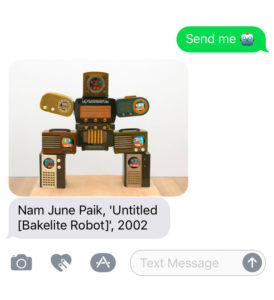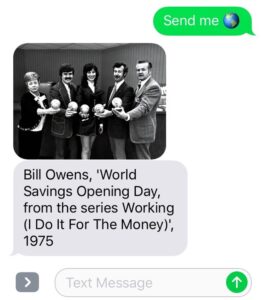
When Send Me SFMOMA made its official debut in mid-June, we hoped to receive 100,000 queries by the end of the summer. We felt that would give us enough data to meaningfully analyze the text service’s use, and help us understand the gaps between how we tag our collection and how our audience would like to explore it. By the end of July, however, we had received over 3.7 million text requests. Needless to say, Send Me SFMOMA has far exceeded our expectations.
Though it was designed to make SFMOMA’s collection more accessible, there are still limits to the service’s reach. For example, the five-digit phone number (572-51) we used to ensure the service wouldn’t be rate limited or blacklisted is not available to all carriers, nor is it available outside of the U.S.
After Send Me SFMOMA went viral in July, appearing in news outlets around the world, the interest in making the service available to international audiences was resounding. SFMOMA’s tweet about an international rollout is the most popular in the museum’s history. As interest mounted, our thinking turned to the broader philosophy that guided the project’s inception. As an exercise in transparency meant to engender discussion about SFMOMA’s collection, this project has clearly succeeded. How, then, would making Send Me SFMOMA internationally available enhance the spirit of the project? This line of thinking led us to two conclusions.
First, while SMS, or texting, is very popular in the U.S. (most carriers offer unlimited texting with their phone plans), other parts of the world have different messaging preferences and access. In Europe and Latin America, for instance, WhatsApp is very popular, whereas in China most people use WeChat.
Second, museums typically reflect the culture and values of their locality. An examination of any museum’s collection will reveal the specific and ever-evolving conversation between the institution and its constituents.
With these thoughts in mind, rather than taking Send Me SFMOMA international, we’ve begun partnering with cultural organizations inside and outside the U.S., providing them with the structure, code, and takeaways from our experiment. Our first partners are Tate (U.K.), Auckland Art Gallery Toi o Tāmaki (New Zealand), Christchurch Art Gallery Te Puna o Waiwhetu (New Zealand), and High Museum of Art in Atlanta. SFMOMA has also spoken to other museums in the U.S. and Europe as well as museums in Australia, Hong Kong and Singapore about potential projects.
If you work in a museum and would like to create your own version of Send Me, email us at digital@sfmoma.org, and we’ll do whatever we can to help you make your collection more accessible through this this framework. There are many arts organizations and libraries with publicly available data, so even if you don’t work at museum, we encourage you to get in touch.
It only takes three things to create your own version of Send Me:
- Publicly accessible data
- A tiny bit of programming
- A deeply engaged public
This summer, you helped us uncover countless hidden gems in the SFMOMA collection. We’re excited to see what gems other institutions have to discover. Stay tuned as we announce partnerships with additional museums and organizations.






